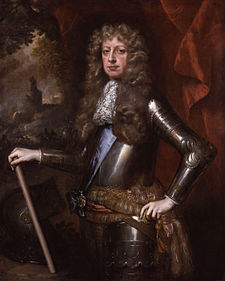Women, in particular, just love a good romance tale and in keeping with my promise to inform you more about what Her Majesty Queen Elizabeth II missed by not visiting Thurles, her native home, during her recent visit to Tipperary, how better to start than with a factual love story.
James Butler, (1610-1688) the first Duke of Ormonde, was born son of Thomas and Elizabeth Butler (Elizabeth Poyntz – Lady Thurles) at Clerkenwell, London on October 19th, 1610, in the house of his grandfather, Sir John Poyntz. Following the shipwreck, off the coast of Skerries in Dublin resulting in the death of his father in 1619, the boy inherited the title Viscount Thurles.
The year following this family disaster and when he was just nine years of age, because of the influence of his grandfather, his mother brought James back to England, and placed him at school with a Catholic gentleman at Finchley. However it was not long before King James I, anxious that the heir of the Butlers should be brought up Protestant, placed him at Lambeth, under the care of the then Archbishop of Canterbury George Abbot, to be brought up in London under the immediate influence of the court. The boy known as Viscount Thurles, was extremely popular, handsome, and in his early teens quickly became recognised as “the man about town.”
The story regarding his future marriage however is most certainly a romantic one. The young 19 year old Viscount Thurles first cast his eyes on his 14 year old orphaned cousin Elizabeth Preston in church. Elizabeth, only daughter and heiress of the Earl of Desmond, was very wealthy as well as being very beautiful. The Title, ‘Earl of Desmond,’ had been first created for Maurice FitzGerald, 4th Baron Desmond in approximately 1329.
The affection between the couple was immediately noted as being reciprocal. Her father, like his, had also been drowned near Skerries on a passage to England. However, the now orphaned Elizabeth was the King’s ward, she was under the care of Henry, Earl of Holland and George Villiers, then the Duke of Buckingham, had intended her as an excellent ‘catch,’ for his young nephew. However, from all that history has left us, this was a case of love at first sight and Viscount Thurles had resolved he was going to wed her.
Elizabeth Preston, being reserved for someone else, was now guarded under the watchful and jealous eye of Lord Holland, and deliberately kept segregated from Viscount Thurles. Realizing from previous meetings, that his attentions would not be regarded as displeasing by the lovely Elizabeth Preston, Viscount Thurles decided that he would continue to pursue her, regardless of the consequences, so he set upon a devious and clever plan.
He disguised himself as a peddler, and carried his wares to the back-door of Lord Holland’s Kensington residence. During this period and often happily for the course of true love, young ladies were delighted to open their doors to travelling peddlers, and Lord Holland’s own daughters performed this service unknowingly for this love struck disguised Viscount. They made a few purchases from his wares, and then hastened to call Elizabeth, telling her that a handsome English peddler was at the back-door, and begged her to come and view his stock.
The girl recognized Viscount Thurles, and when he urged her to purchase a pair of gloves, she requested him to wait while she went to get some money. Her companions offered to lend her the necessary purchase price, but Elizabeth declined, guessing that one of the gloves could possibly contain a love-note.
Now in the safety of her own room, she read Viscount Thurles’ impassioned letter, and having penned him a favourable reply, came down to the door again and angrily returned the gloves, declaring that they smelt abominably, and could not be worn by any lady of her standing. The disguised peddler accepted the cancellation of this sale and hurridly left, the message in the gloves now settling his doubts and fears, regarding Elizabeth’s true feelings for him.
Women were expensive commodities to maintain even then, and Lord Holland’s consent to the future marriage by James Butler to Elizabeth Preston had to be purchased at a cost of £15,000, which when paid allowed for the smoothing away of the many difficulties opposing this suit. In September 1629, King Charles issued letters patent consenting to this match, on the grounds that it would put a “final end to all controversies between Walter, Earl of Ormond, and Elizabeth, daughter of Richard, Earl of Desmond.”
The groom, James, then but nineteen years and his bride Elizabeth but fourteen years, would now wed in London, during Christmas 1629. The following year, they passed together at her home in Acton, where he devoted his time to study, making up somewhat for past deficiencies in his education, and at the end of 1630 they came over to Ireland, first to rented accommodation in Carrick-on-Suir and later to Thurles and Kilkenny.
The coming of James, Earl of Ormonde to the country and county of his ancestors, was hailed as a welcome sign by most of the then leading Irish families. He was a Protestant, the result of his education in England, but the question of religion was ignored by the Irish, and the handsome and chivalrous Earl was called upon to take his stand in the forefront of the then Irish army.
It seems, Love will always find a way.


George,
What a fantastic and enligthening article on the background of Queen Elizabeth. Such a pity she didn’t get to visit her ancestral home….Thurles.
Regards Nuala.
Nuala,
A lot of our so called public representatives are already running for cover. This will be so funny to watch over the coming weeks. But watch this site next week as we reveal the true Hidden Tipperary. You will be amazed.